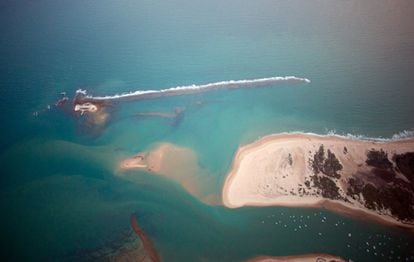Mattan died of suffocation in a severe fire that swept through part of the city of Gadir, sometime between the late 7th and early 6th centuries BC. The body of this 35-year-old gadirita, buried among the remains of streets and houses, is one of the hundreds of pieces of the puzzle from Cádiz's Phoenician past that archaeologists have been trying to piece together for more than a century. Each finding and hypothesis moves the exciting puzzle that, in the last two decades, has rewritten the known history of one of the most important and richest colonies founded by the inhabitants of Tire (in present-day Lebanon) beyond the Strait of Gibraltar, in the confines of your known world.The new proposal for the location of the famous temple of Melqart in the Sancti Petri area (between San Fernando and Chiclana) could be the answer to one of those great unknowns that mark a Cadiz past in constant revision and recomposition. The scientists consulted have many doubts and only one certainty: in Gadir there is still a lot of room for big surprises.
The archaeological remains place the Phoenician settlement on the islands that made up the Bay of Cádiz between the end of the 9th century and the beginning of the 8th century BC, not so far from the date given by the Roman historian Veleyo Patérculo, who established the foundation of Gadir in 1104 BC, exactly 80 years after the fall of Troy. The Orientals should not be unknown to the natives who lived in the area at the end of the Bronze Age since, as archaeologist Paloma Bueno argues, the newcomers "followed very old trade routes" known for many years. For now, there is no evidence that those first inhabitants resisted, but they did appreciate what these newcomers offered them. “The Phoenician was liked by the whole Mediterranean because its ceramics, its dyeing of fabrics,your furnaces or new grinding types. It was a technological revolution, ”says Bueno.
There are no doubts among the experts as to why they chose the current Cádiz for one of their oldest foundations, along with Útica and Cartago (in present-day Tunisia). The Gulf of Cádiz offered them silver and other metal mines, fishing resources such as bluefin tuna and an enviable geostrategic position. “It was a logistics center. Cádiz played a role similar to that of Carthage in controlling the central Mediterranean ”, says Ángel Muñoz, archaeologist and head of the Department for the Protection of Historical Heritage of the Junta in Cádiz. But what is not so clear is what point they chose to locate the city - or cities - and its temples, from the best known of Melqart, to those of Astarte or Baal Hammon that the Greco-Latin sources cite.
Recreations directed by the archaeologist José Gener of what Cádiz was like during the 7th century BC, divided into two islands.
In the evolution of that original city during the more than 500 years that elapsed until the arrival of the Romans in the 1st century BC, only one thing remained unchanged: the temple of Melqart. “It was always the important thing. It was a reference for locals and foreigners. It is a maritime and economic landmark and a center of wisdom ”, points out Antonio Saez, professor in the Department of Prehistory at the University of Seville and a partner in the new hypothesis of the location of the Melqart sanctuary. So much so that the consecration of the monument to the main Phoenician deity occurred shortly after the founding of Gadir, as a legitimation of the settlement of the city. "On a pragmatic level, the invocation of a god protects you," explains Ana María Niveau de Villedary, a professor of Prehistory at the University of Cádiz specializing in the Phoenician world.
Inside the temple, commercial deals were entrusted or coins were minted. Its importance was such that it transcended Gadir itself and, by the work and grace of syncretism, the monument ended up consecrated as that place dedicated to the Roman Hercules in which Julius Caesar wept bitterly, realizing that he had not achieved the same feats that the conqueror Alexander the Great.
But another very different thing is to locate the place where the building could be. Some experts place it in the Cerro de los Mártires - as the hypothesis of the University of Córdoba and Cádiz assures - or in Sancti Petri - as defended by the University of Seville and the Andalusian Institute of Historical Heritage. Finding its location would be “the jackpot” of all the unknowns that Gadir raises, as the professor at the Complutense University of Madrid, Mariano Torres, assures, due to the large number of answers it could give about the life and politics of the Gadiritas.
In those years, the bay was an archipelago of islands, of which two stood out: Kotinoussa and Erytheia, both close, but divided by a natural channel.
That division, discovered at the beginning of 2020 by the archaeologist Darío Bernal, was one of those blows on the table that reconfigured the known panorama of that time.
“This is under constant construction and deconstruction.
You have to have scientific honesty to know when what you said 10 years ago is no longer valid.
It's what stimulates me, ”explains Niveau de Villedary.
A city in time
But the doubts about its territorial organization go much further. For now, there is evidence of Phoenician settlements in Doña Blanca (in El Puerto de Santa María, the most extensive site), various points in Cádiz capital, in San Fernando (in this case, they are ceramic kilns) and in Chiclana de la Frontera. (the most recent find still under excavation). What is not so clear is whether all these points functioned as a single administrative entity, as a joint city that even shared a place name. Bueno and Muñoz are in favor of this possibility. "Greek sources speak to us in the plural of Gadeiras, as a set of cities and occupations," explains the expert, in charge of the Chiclana excavations. But Torres has his doubts: “All of them should have been part of the same political entity,but Gadir applies to the area of present-day Cádiz ”.
Although for Saez, an even more interesting question arises: "We talked about what Gadir is, but it has gone unnoticed that the city has its ups and downs, with times of bonanza and lean cows." The presence of Mattan himself - a name given by his discoverers -, abandoned on the island of Erytheia, speaks of how the Phoenicians rebuilt the area after a catastrophic event, but ended up abandoning it just half a century later for an unknown reason. That change, in the middle of the 6th century BC, coincides with a period of conflict in the Mediterranean and with a powerful reorganization of Gadir. “Perhaps then they achieved independence, already detached from the East. Perhaps they went from a colonial-type organization to independent cities with assemblies that could be equated to the Greek polis, ”says Torres.
The islet of Sancti Petri, the pipe and the tip of the Boquerón, the place where the Melqart temple could be located, according to a final hypothesis.Juan Carlos Toro
The doubt, for now, seems difficult to clear, given the absence of epigraphs left by those gadiritas and of great investigations in Tire or Sidon —also in Lebanon—, due to the instability that the area has suffered in recent decades. What is clear is that what followed is the greatest period of splendor of Gadir, attested by the tomb of a priest in the Casa del Obispo de Cádiz, the imposing anthropomorphic sarcophagi - male and female - that are preserved in the Museum of Cádiz or the minting of coins. “Gadir was of great importance because it is going to become the commercial center of the Huelva mines, salted fish or the tin route. It was enormously rich, "explains Torres.
For each rethinking of what is known about ancient emporium, the foundations of Gadir's history are shaken to give way to a new reality still under construction.
But archaeologists do not perceive these changes as failure.
“We make the best possible model with the available data.
The greater the number of evidences, the less the changes will be, ”says Torres.
“I find it so exciting because we are creating a new explanatory model.
There came a time when we had to break the explanatory models of the past because they were no longer valid.
You have to investigate and be creative ”, enthuses Niveau de Villedary.




/cloudfront-eu-central-1.images.arcpublishing.com/prisa/LICFOABLMFBFZJ5EDBCNVTC35U.jpg)



/cloudfront-eu-central-1.images.arcpublishing.com/prisa/RGXZZ7HKWRCKLCNNNFDNLABHZI.jpg)
